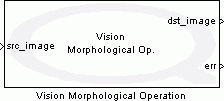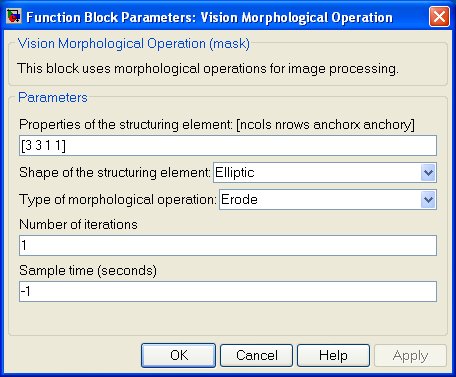

Vision Morphological Operation

|
This block is currently a beta version. If you are using this block, we would appreciate any feedback at tech@quanser.com. |
Performs morphological transformations on the input image.
Library
QUARC Targets Beta/Image Processing/Open Source Computer Vision MATLAB Command Line Click to copy the following command line to the clipboard. Then paste it in the MATLAB Command Window: qc_open_library('quarc_library_beta/Image Processing/Open Source Computer Vision')
Description

The Vision Morphological Operation block performs morphological transformations on the input image using the specified structuring element.
In order to use this block, be sure to follow the instructions described on the Vision Capture Image page, and take careful note of the limitations.
Input Ports
src_image
A handle to a source image that uses OpenCV (Open Source Computer Vision) IplImage structure.
Output Ports
dst_image
A handle to a destination image that shows results of morphological operations on input image. The number of color planes in destination image is the same as that in input image.
err
An error signal which is negative in case of invalid memory allocation or usage of invalid parameter values.
Parameters and Dialog Box

Properties of the structuring element
Specify the properties of the structuring element, namely, the number of columns (ncols), the number of
rows (nrows), and the center of structuring element (anchorX, anchorY).
Shape of the structuring element
Specifies the shape of structuring elementl. The available shape options are Rectangular, Cross-shaped,
and Elliptic.
Type of morphological operation
Specifies the type of morphological operation to be applied on the input image. The available options for morphological
transformation are Erode, Dilate, Open, Close, Gradient, Tophat, and Blackhat.
The options are described as follows:
Erode:
dst_image=erode(src_image, element): dst_image(x,y)=min((x',y') in element))src_image(x+x',y+y')
Dilate:
dst_image=dilate(src_image, element): dst_image(x,y)=max((x',y') in element))src_image(x+x',y+y')
Open:
dst_image=open(src_image,element)=dilate(erode(src_image,element),element)
Close:
dst_image=close(src_image,element)=erode(dilate(src_image,element),element)
Gradient:
dst_image=morph_grad(src_image,element)=dilate(src_image,element)-erode(src_image,element)
Top hat:
dst_image=tophat(src_image,element)=src_image-open(src_image,element)
black hat
dst_image=blackhat(src_image,element)=close(src_image,element)-src_image
Number of iterations
Specifies how many times the specified morphological operation will be applied on input image.
Sample time
The sample time of the block. A sample time of 0 indicates that the block will be treated as a continuous time block. A positive sample time indicates that the block is a discrete time block with the given sample time. A sample time of -1 indicates that the block inherits its sample time.
Targets
|
Target Name |
Compatible* |
Model Referencing |
Comments |
|---|---|---|---|
|
No |
No |
Not supported. |
|
|
No |
No |
Not supported. |
|
|
Yes |
Yes |
||
|
Yes |
Yes |
||
|
Yes |
Yes |
||
|
Yes |
Yes |
||
|
Yes |
Yes |
||
|
Yes |
Yes |
||
|
Yes |
Yes |
||
|
Yes |
Yes |
||
|
Yes |
Yes |
||
|
Yes |
Yes |
||
|
Yes |
Yes |
||
|
No |
No |
Not supported. |
|
|
Rapid Simulation (RSIM) Target |
No |
No |
Not supported. |
|
S-Function Target |
No |
N/A |
Old technology. Use model referencing instead. |
|
Normal simulation |
Yes |
Yes |

Copyright ©2025 Quanser Inc. This page was generated 2025-11-01. Submit feedback to Quanser about this page.
Link to this page.